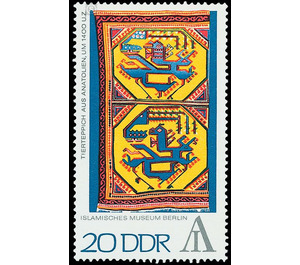International Stamp Exhibition - Germany / German Democratic Republic 1972 - 20 Pfennig
Theme: Art & Culture
| Country | Germany / German Democratic Republic |
| Issue Date | 1972 |
| Face Value | 20.00 |
| Color | multi-colored |
| Perforation | K 14 |
| Printing Type | Photogravure |
| Stamp Type | Postage stamp |
| Item Type | Stamp |
| Chronological Issue Number | 1529 |
| Chronological Chapter | GER-DDR |
| SID | 945859 |
| In 24 Wishlists | |
International Stamp Exhibition in the GDR "Interartes" For the International Stamp Exhibition in the GDR "interartes", the Ministry of Posts and Telecommunications of the German Democratic Republic issued four multicolored special postage stamps, two of them with surcharge. The sums collected will be handed over to the Philatelistenverband der DDR in the Kulturbund. INTERARTES 72 in the Staatliche Museen zu Berlin For the fourth time, stamps of the German Democratic Republic present exhibits of the State Museums of the GDR's capital city, Berlin. While the series of 1958 and 1959 saw the rescue and return of significant works by the Soviet Union, and advertised the 1966 edition for Babylonian art treasures, the most recent issue is INTERARTES 72, a stamp exhibition with international participation 14 countries, thematically dedicated to the field of art and culture and takes place from 4 October to 5 November 1972 in the Old Museum on Marx-Engels-Platz and in front of the world-famous Pergamon Altar in the Pergamon Museum am Kupfergraben. With this exhibition, the Philatelistenverband der DDR in the Kulturbund, in close cooperation with the Staatliche Museen zu Berlin, is taking a completely new, promising path by presenting the stamp exhibits, the themes of architecture, fine and applied arts, folk art, literature, music and the arts treat the performing arts, original works of art from the respective areas are set aside. Paintings, graphics and sculptures, architectural drawings and models, products of folk art, books and autographs of famous writers, musical instruments and scores, set design and posters and much more, enter into a direct, living relationship to the diverse message of the stamp exhibits. In this way, philately is for the first time placed organically in the great frame of art and culture. In detail, the four INTERARTES commemorative stamps show the following art treasures of the Staatliche Museen zu Berlin: 20 Pfennig Value Among the very special treasures of the Islamic Museum is the animal carpet with the motif of dragon and phoenix. A very similar piece was reproduced on a mural around 1440 in Siena in Italy. It is therefore assumed that our carpet was created in the 15th century. At that time, Italian trading cities maintained strong ties with the Turkish Empire, and Asia Minor carpets were imported in large numbers to Italy and thence to all of Europe. They served to decorate the churches, the palaces and the homes of wealthy citizens. The motif of dragon and phoenix, which is depicted twice on the carpet, is of East Asian origin and reached Mongolia through the Mongolsturrn in the 13th century. Thus, this carpet illustrates the worldwide relationships that can flow together in a work of art and that range here from East Asia via Anatolia to Italy.


